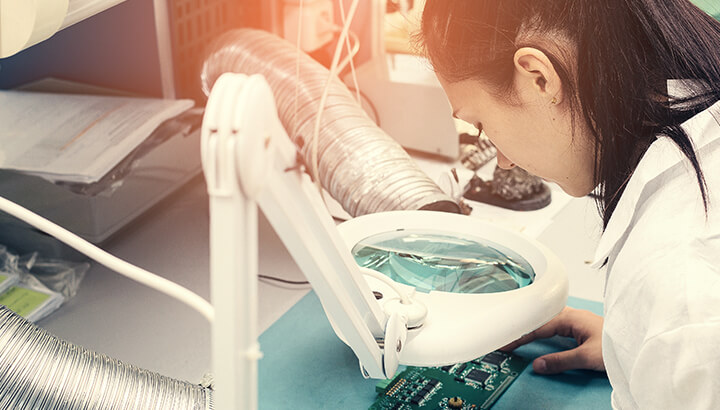Removing Conformal Coatings
Conformal coatings are polymeric films applied directly to PCBAs and electronic components to provide a barrier layer of protection from the environment in which they operate. There are five primary conformal coating materials: acrylics, epoxies, silicones, urethanes, and Parylene. Each material presents its advantages, limitations, challenges, and application methods.
Learn about conformal coating application methods
Acrylic (AR) Conformal Coating Properties
- Low moisture absorption
- Relatively short drying times
- Clear protective coating
- Good electrical and physical properties
- Typically brushed, sprayed, or dipped
Read more about how to choose the best conformal coating
Epoxy (ER) Conformal Coating Properties
- Very robust
- Excellent chemical and abrasion resistance
- Very rigid conformal coating
- High dielectric strength
- Typically brushed, sprayed, or dipped
Read more about epoxy conformal coatings
Silicone (SR) Conformal Coating Properties
- Good humidity and moisture resistance
- Low toxicity
- Easy to apply
- Easy to repair
- Typically brushed, sprayed, or dipped
Properties of Urethane (UR) Conformal Coatings
- Moisture and oil resistant
- Fungicidal
- Good flexibility
- Can be thinned to achieve a chosen viscosity
- Typically brushed sprayed or dipped
Read more about urethane conformal coatings
Properties of Parylene (XY) Conformal Coatings
- Biostable, biocompatible
- Excellent chemical resistance
- Superior conformality
- Exceptional corrosion resistance
- Applied by chemical vapor deposition (CVD)
Understand the difference between conformal coating and potting
Read the definitive paper on electronic protection methods
Every so often, conformal coatings must be removed. This may be for several reasons, including electrical or functional failures that require rework, PCBA malfunctions, initial design process issues, poor adhesion, conformal coating defects, or improper choice of coating material. Whatever the reason, the first step in the removal process is to determine which coating material you are working with, as this will help determine how to remove the PCB coating.
How to Remove Conformal Coating
To determine the best conformal coating removal method, confirm the coating material applied to the PCB you are looking to remove. Confirmation can typically be achieved by either contacting your coating supplier or looking for a JEDEC or IPC label placed on the board. Coatings are designated as AR, SR, ER, UR, or XY, indicating with which coating you are working. If there are no labels, you can still ID the material via methods outlined by the IPC below.
Because each conformal coating has distinct properties, using methods such as testing transparency, testing solubility, testing hardness, testing thermal removal, and testing thickness can show you which type of coating you are working on. For more information, see IPC’s “Coating Removal, Identification of Conformal Coating” guidelines.
Conformal Coating Removal Techniques
After identifying your coating, the next step is to choose the removal technique. Popular methods are briefly discussed below:
Peeling Method
Typically used for RTV silicone or thick rubber coatings, use a dull blade or knife to slit the coating material and peel it off.
Chemical Solvent Method
This process is very effective for removing urethane, acrylic, and silicone coatings. Prep the area with high-temperature tape and apply solvent using a foam swab.
Grinding and Scraping Method
This removal technique can grind away thin, hard coatings with a micro motor or rotary-style tool or soft coatings with a rotary brush.
Thermal Method
Using low-temperature heat, gently burn and melt the coating material.
Micro Sandblaster Method
This technique involves projecting a fine abrasive powder onto the coating to flake off the material.
Which Technique is Best for My Conformal Coating Material?
Urethane Coatings
- Grinding and scraping method
- Solvent method
- Micro-blasting method
Acrylic Coatings
- Thermal removal method
- Chemical solvent method
- Scraping and grinding method
- Micro-blasting method
Epoxy Coatings
- Thermal removal method
- Grinding and scraping method
- Micro-blasting method
Silicone Coatings
- Grinding and scraping method
- Micro-blasting method
- Chemical solvent method
- Thermal method
Parylene Coatings
Parylene coatings are often harder to remove, but you can typically use the micro-blasting method, grinding and scraping method, and thermal method. However, at HZO, we have simplified the reworking process using technology. In the next blog in this series, we will discuss reworking Parylene in general and detail how we simplify the process.
For more information on thin-film coatings for your project, contact us today.
Discover how HZO can protect your product


